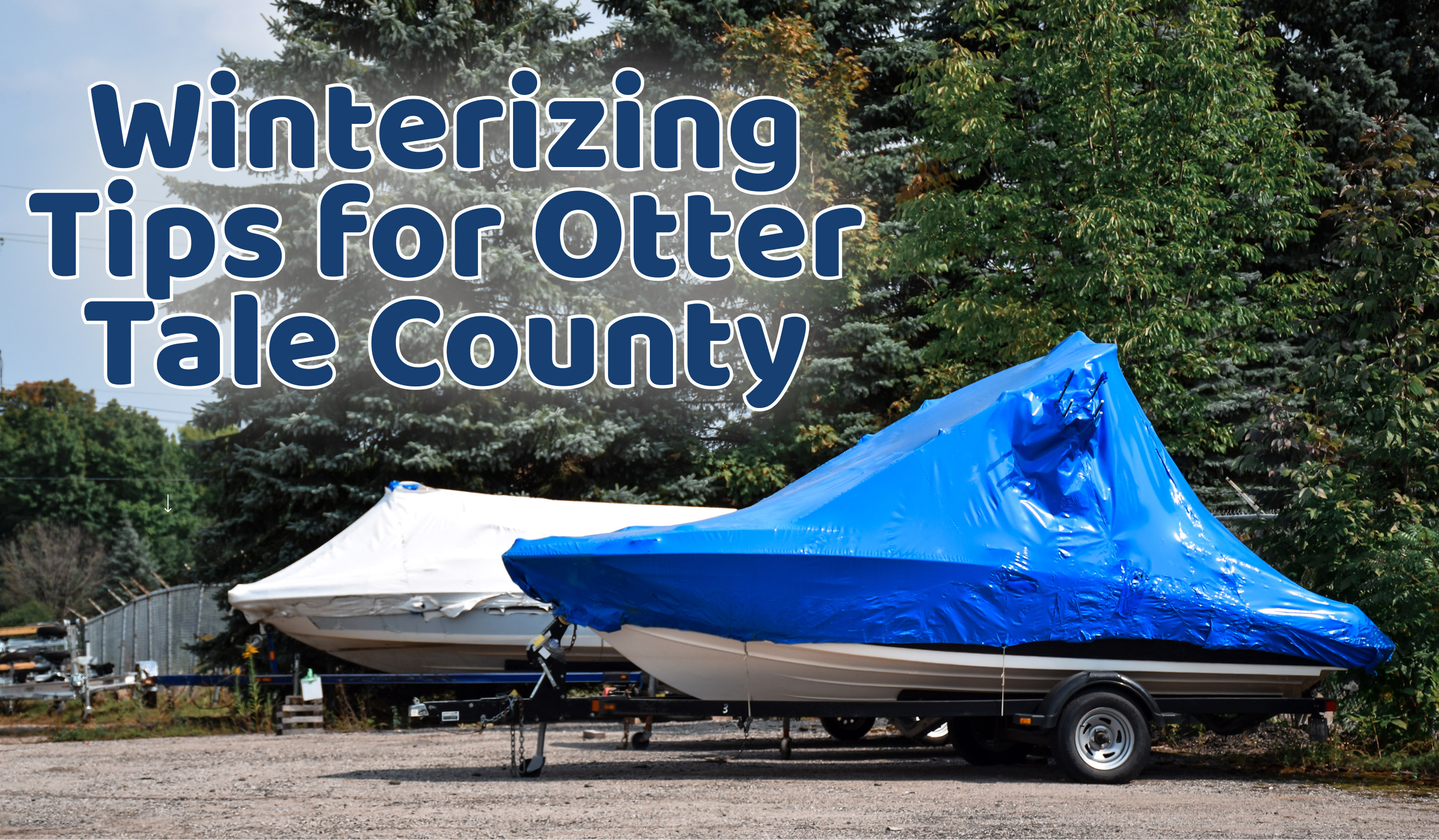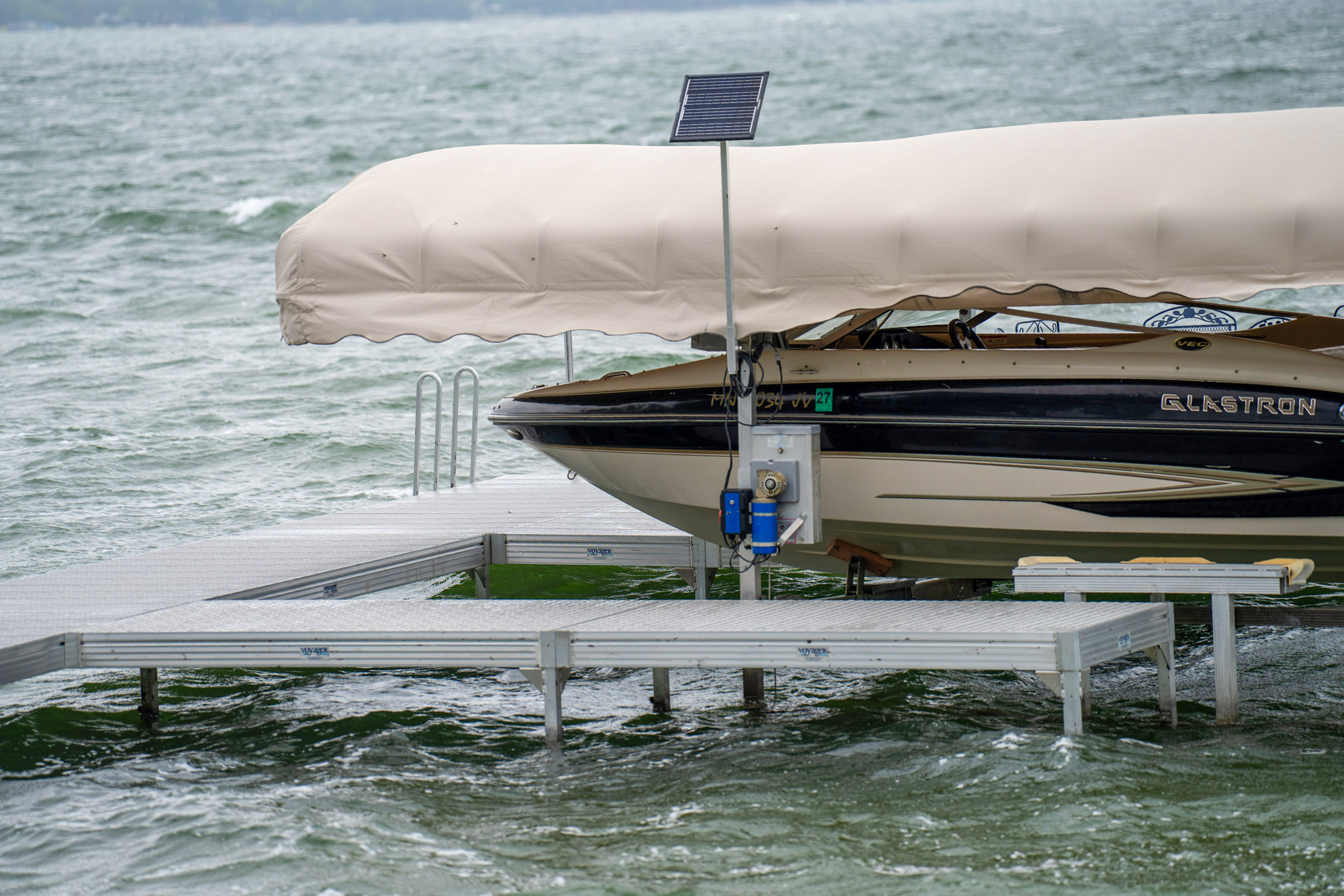
Protect your entire marine investment with proper preparation before Minnesota's harsh winter arrives
A Note from Enclave Marine: After over a decade of serving Otter Tail County lake property owners, we've seen what happens when boat lifts and boats aren't properly winterized. From costly spring repairs to complete system failures, the consequences of poor winter preparation can be devastating. This guide represents our accumulated expertise helping thousands of property owners protect their entire marine investment season after season.
Minnesota winters are unforgiving to marine equipment, and your boat lift and boat represent significant investments that deserve proper protection. Whether you're a first-time lake property owner or a veteran looking to refine your winterization process, understanding the critical steps can mean the difference between smooth spring startup and expensive repairs.

Ice formation exerts tremendous force on both boat lift components and boats themselves. When water freezes, it expands with enough pressure to crack metal, damage hydraulic systems, and destroy moving parts. Minnesota's freeze-thaw cycles create repeated stress that can fatally compromise unprotected equipment.
For boats, trapped water in engines, cooling systems, and plumbing lines can cause catastrophic damage. A single freeze event can crack engine blocks, destroy pumps, and render boats completely inoperable.
Beyond ice damage, Minnesota's temperature swings cause metal components to contract and expand repeatedly. Moisture trapped in hydraulic lines, motor housings, fuel systems, or gear assemblies can freeze and cause expensive internal damage. Proper winterization eliminates these moisture sources and prepares your equipment for months of harsh conditions.
Different boat lift and boat systems require specific winterization approaches:
Hydraulic Lifts need complete fluid system protection, with special attention to rams, pumps, and reservoir tanks. Hydraulic fluid can thicken in extreme cold, putting excessive strain on pumps and potentially causing seal failures.
Cable and Winch Systems require comprehensive lubrication of cables, pulleys, and winch mechanisms. Metal cables are particularly vulnerable to moisture infiltration, which causes internal corrosion that weakens lifting capacity.
Pneumatic Lifts demand complete air system drainage and valve protection. Compressed air systems trap moisture that can freeze and block air lines or damage control valves.
Outboard Motors require complete cooling system drainage, lower unit gear oil changes, and fuel system treatment. The cooling passages in outboards are particularly vulnerable to freeze damage.
Inboard/Sterndrive Engines need comprehensive cooling system winterization, including engine block draining, heat exchanger protection, and raw water system treatment. These closed-loop systems can trap water in multiple locations.
Jet Drive Systems require impeller housing drainage, cooling system protection, and intake screening to prevent debris accumulation during storage.

Start watching extended forecasts once nighttime temperatures consistently drop below 40°F. The National Weather Service provides detailed long-range forecasts for the Otter Tail County region that help predict optimal winterization timing.
Begin gathering necessary supplies for both boat lifts and boats: appropriate lubricants, hydraulic fluid, antifreeze solutions, marine antifreeze, fuel stabilizers, protective covers, and cleaning materials. Quality winterization products designed for marine applications significantly outperform generic alternatives. The BoatUS Foundation provides comprehensive guides on selecting proper winterization supplies.
Boat Lift Winterization Steps:
Step 1: Complete System Inspection
Examine all visible components for signs of wear, damage, or corrosion. Document any issues requiring spring repair or replacement. Check cable condition, hydraulic ram seals, electrical connections, and structural integrity.
Pay special attention to areas where dissimilar metals contact each other, as these locations experience accelerated galvanic corrosion during freeze-thaw cycles.
Step 2: Drain All Water Sources
Remove water from hydraulic reservoirs, motor housings, and any system components where moisture can accumulate. Even small amounts of trapped water can cause expensive damage during freezing.
For hydraulic systems, drain and replace hydraulic fluid if it appears contaminated or hasn't been changed in two seasons. Fresh fluid performs better in cold temperatures and provides superior component protection.
Step 3: Lubricate Moving Components
Apply marine-grade lubricants to all moving parts: pulleys, pivot points, cables, and mechanical connections. Use lubricants specifically formulated for extreme temperature performance—generic automotive products often fail in severe cold.
Cable systems require particular attention. Apply penetrating lubricant to the entire cable length, working it into the cable strands to displace moisture and prevent internal corrosion.
Step 4: Protect Electrical Systems
Disconnect and remove batteries, storing them in heated areas where they can be maintained properly throughout winter. Clean all electrical connections and apply dielectric grease to prevent corrosion.
Cover control panels and electrical components with waterproof protection. Even small amounts of moisture infiltration can cause expensive electrical failures.
Boat Winterization Steps:
Engine Winterization
For outboards, run the engine in a water tank or with flushing attachment while adding marine antifreeze to the cooling system. Continue running until antifreeze appears from the exhaust ports. Change lower unit gear oil, inspecting the old oil for water contamination that indicates seal problems requiring certified marine technician attention.
For inboard and sterndrive engines, drain the raw water cooling system completely, then fill with marine antifreeze. Remove the drain plugs from engine blocks, manifolds, and heat exchangers. Change engine oil and filter before storage, following API certification standards for marine applications.
Fuel System Protection
Add fuel stabilizer to prevent fuel degradation during storage. Fill the fuel tank to prevent moisture accumulation, then run the engine briefly to circulate stabilized fuel through the entire system. The National Marine Manufacturers Association recommends specific fuel treatment procedures for different engine types. For long-term storage, consider draining fuel systems entirely following EPA guidelines for proper fuel disposal.
Boat Interior and Exterior
Remove all water from livewells, ballast tanks, and freshwater systems. Clean the boat thoroughly, removing organic materials that can cause odors or attract pests during storage. Apply protective wax to gel coat surfaces following American Boat and Yacht Council standards.
Remove cushions, electronics, and valuables that could be damaged by temperature extremes or moisture. Ensure adequate ventilation to prevent mold and mildew formation. The U.S. Coast Guard Auxiliary provides detailed checklists for proper boat storage preparation.
Boat Lift Final Preparation
Position for ice protection by raising your boat lift to its highest possible position to minimize ice contact with critical components. Ice typically forms at the waterline first, so maximizing clearance reduces direct ice pressure on lift mechanisms.
For areas prone to significant ice buildup, consider installing ice protection systems like bubblers or de-icers around lift structures. The Ice Eater and Power House manufacturers provide detailed sizing guides for effective ice prevention systems. These systems prevent solid ice formation that can damage lift legs and underwater components.
Install protective covers on motors, control panels, and electrical components with weatherproof covers designed for marine applications. Ensure covers allow for air circulation while preventing direct moisture contact. Completely sealed covers can trap condensation, creating ideal conditions for corrosion.
Boat Storage Preparation
If storing your boat on the lift, ensure it's properly supported and secured. Remove the drain plug to allow any remaining water to escape. Cover the boat with a breathable cover that prevents moisture accumulation while protecting from snow and debris.
For boats stored off-season in heated facilities, inspect storage agreements and prepare for transport. Document the boat's condition before storage and ensure insurance coverage remains active during storage periods. The National Association of Marine Surveyors provides guidelines for proper documentation and condition assessment.

Otter Tail Lake's unique characteristics require specific winterization approaches. The lake's shallow areas freeze earlier and more completely than deeper sections, meaning lift positioning relative to water depth affects ice pressure exposure.
Properties on West Battle Lake face different ice conditions due to the lake's smaller size and different wind patterns. Consult with local marine service providers familiar with your specific lake's ice behavior patterns.
The Minnesota Department of Natural Resources provides ice thickness monitoring data that helps predict severe ice years requiring additional protective measures.
DIY Approach Benefits:
Professional Service Advantages:
Consider your comfort level with mechanical systems, available time, and the value of your equipment investment when choosing approaches. The International Association of Marine Investigators provides resources for evaluating service provider qualifications.
Boat Lift Mistakes:
Boat Winterization Mistakes:
Universal Mistakes:
Document your winterization process to streamline spring startup. Note fluid types used, replacement parts needed, and any issues discovered during preparation.
Schedule professional spring inspection and startup services before peak season demand. Quality marine service providers book spring schedules during winter months when availability is better.
Complete Removal and Storage:
In-Water Winterization:
Consider your specific lake conditions, lift type, and storage options when making this decision.
Even properly winterized lifts benefit from periodic winter inspection, especially after severe weather events. Extreme temperature swings, heavy snow loads, or unusual ice conditions can affect even well-prepared equipment.
Establish a schedule for visual inspection every 4-6 weeks during winter months. Look for obvious damage, shifted positions, or ice pressure effects that might require spring attention.
If you choose professional winterization services, schedule appointments by early September to ensure availability during optimal timing windows. Quality providers book their fall schedules well in advance.
Discuss both winterization and spring startup services simultaneously. Many providers offer package deals combining both services with storage options.
Professional winterization services for both boat lifts and boats typically cost $400-1,200 depending on equipment complexity and services included. Compare this investment against potential repair costs: hydraulic system rebuilds often cost $1,000-3,000, while engine freeze damage can require $2,000-8,000 in repairs, and complete equipment replacement can exceed $15,000.
Factor in your time investment, tool requirements, and comfort level with technical procedures when evaluating DIY approaches. Boat winterization alone can require 6-8 hours for thorough completion, while lift winterization adds another 2-4 hours depending on system complexity.
Use environmentally appropriate lubricants and fluids that won't harm lake ecosystems if accidentally spilled. The Minnesota Pollution Control Agency provides guidelines for lake-safe marine products, while the Environmental Protection Agency sets federal standards for marine environmental protection.
Properly dispose of used fluids, old components, and worn materials at appropriate recycling facilities rather than standard household waste. The Minnesota Department of Natural Resources Recycling Program provides locations for hazardous marine waste disposal throughout Otter Tail County.
Your boat lift represents a significant investment in your lake property enjoyment and value. Proper winterization protects this investment while ensuring reliable performance for years to come.
Whether you choose professional service or DIY approaches, the critical factor is thoroughness. Half-measures in winterization often prove more expensive than complete protection or professional service.
For professional boat lift and boat winterization services throughout Otter Tail County, contact Enclave Marine in Battle Lake. Our experienced team has protected thousands of boat lifts and boats through Minnesota's harsh winters, ensuring trouble-free spring startups and maximum equipment longevity.
Meta Title: Boat Lift & Boat Winterization Guide for Minnesota | Otter Tail County
Meta Description: Complete guide to winterizing your boat lift and boat for Minnesota winters. Expert tips, timing, and techniques to protect your marine investment in Otter Tail County.